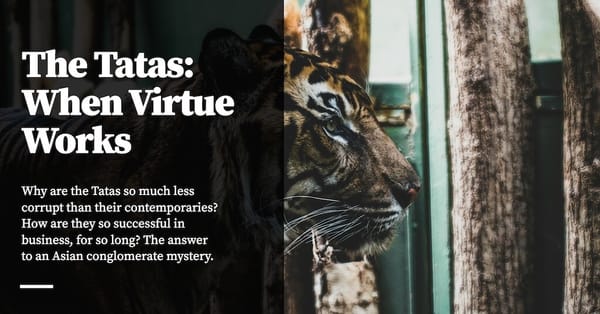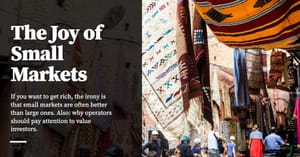Why are the Tatas so much less corrupt than their contemporaries? How is their conglomerate still intact after five generations? The answer to an Asian conglomerate mystery, and Part 13 of the Asian conglomerate series.
Note: This is Part 13 in a series of articles and cases on Asian Conglomerates. Read Part 12 here. You may read more about the Asian Conglomerate Series here, or view all the published cases here.
We last looked at the Tatas — India’s preeminent business family — in Part 10 of the Asian Conglomerate Series, The Origin of the Tatas.
In that essay, I described the biggest mystery that leapt out at me when studying the conglomerate:
There is much to say about the Tata group, and there is much that is unique about their business structure. At this point in the Asian Conglomerate series we know why corruption exists wherever weak institutions, regulation, and the pressures of competitive arbitrage exist. To my mind, the most interesting question about the Tatas is this: how did they get by with so little corruption?
The answer to this question is both an accident of history, as well as remnants of the personal values of Jamshetji Tata, born 1839, died 1904 — a British subject his entire life, and a giant of a man.
In this piece, we’ll talk about that ‘accident of history’ that I alluded to in the last piece. We’ve published a new case as a companion to this essay: The Early Legacy of the Tatas: Steel, Science and Power.
Please read that case before you read this analysis — that case is well-researched. This piece, on the other hand, will contain opinions that may or may not be fully substantiated by the evidence. This is the only way that I can make my case for why the Tatas are less corrupt; you have been warned.
A Good Man
The Tatas are truly one of the most remarkable business families. Several businesses in the Tata group are amongst the largest on the Indian subcontinent; the group is loved by many in India.
That said, five generations on, you would be hard-pressed to find a single Tata in the top 10 of any of Asia’s numerous rich lists. And it’s not as if the Tata Group has shrunk: far from it. The answer is more prosaic: starting from Jamshetji on down, the family’s ownership of their companies have been held in trusts, institutionalising their control of the group’s businesses whilst preventing any one individual from getting too rich or too powerful. Each of these trusts have boards; the vast majority of the trusts were set up with charitable — and sometimes patriotic! — mandates.
This style of family ownership is most unusual amongst the Asian tycoons. The late Ratan Tata, for instance, the most prominent of the Tatas of the modern era, owned no more than 1% of the holding company over the course of his life. This was worth about £300m in 2008 (around US$690m today). Ratan was head of the group when they bought Land Rover and Jaguar from the British in the late 2000s — an act that the British press deemed ‘reverse colonialism’. This minority stake is to be expected: around two thirds of the Tata Group are currently owned by charitable trusts, set up by various family members over the years. These trusts funnel dividends and proceeds from the companies to causes as diverse as education, healthcare and rural development.
It is in this manner that the spirit of Jamshetji lives on. And he should know it. He started it, after all ... at the turn of the century:
Jamshetji then wrote to Lord Reay, chancellor of Bombay University, about his scheme and proposed setting up a trust settlement of property annually yielding between Rs. 80,000 and a Lakh for the university. He wanted to combine this trust with another trust settlement that he had previously executed in favour of his sons and their descendants.
To avoid abuse by a large body of trustees and mismanagement, he suggested that his family become ‘hereditary managers’ with liabilities to the governing body of the university. In this arrangement, a proportion of the net income of the trust would go towards maintenance of the university and if the income grew over a certain limit, a far larger portion would go to the university, which would be proportionately less than what his descendants would receive.
Jamshetji’s fight to set up an institute of higher learning so consumed him that he put his personal fortune on the line:
Jamshetji was not one to back down. If the British would not fund the university, so be it. He made clear in an amendment to his will that his executors shall ‘provide sufficient property or funds for the university’. Jamshetji had gone so far as to request his partners at the Empress Mills and colleagues to give a part of their commission to the university. However, they were not as generous and declined. Jamshetji was hurt and disappointed by this. To him, the university was more than a noble pursuit; it was the cornerstone of a self-reliant India, decades before the idea of independence became real.
Jamshetji passed away on May 19, 1904. While the country mourned Jamshetji’s loss, the Government of India (GOI) approached his sons regarding the university scheme. Both sons assured the government that they were willing to fulfil their father’s dream. Dorabji met with Curzon to inform him that if the government did not provide adequate financial support, they would withdraw the offer and find another way to utilise the money for educational purposes.
This sort of thing makes an impression on you, if you were one of his lieutenants, or one of his two sons.
Originally published , last updated .
This article is part of the Market topic cluster, which belongs to the Business Expertise Triad. Read more from this topic here→





